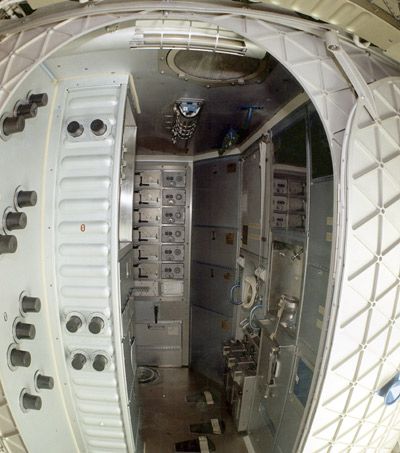If you asked the question, "How do astronauts eat in space?" about fifty years ago, the answer would be quite different than it is today. In space travel's early years, astronauts used straws to suck dehydrated, paste-like food out of tubes. Today, astronauts on the space shuttle eat food in much the same way as they do here on Earth.
In a low-gravity environment, food and drinks would simply float away if they weren't handled correctly. To combat this problem, food is carefully contained and drinks are packaged as dehydrated powders. The astronauts add water to beverages through a special tube before drinking.
Advertisement
Foods are either partially or completely dehydrated to prevent them from spoiling. Meats are exposed to radiation before they are put onboard the shuttle to give them a longer shelf life.
Astronauts eat three meals a day (plus periodic snacks), just as they do on Earth. Meals are organized by the order in which astronauts are going to eat them, and stored in locker trays held by a net so they won't float away. When mealtime rolls around, astronauts go into the galley area in the shuttle's middeck. There they add water to freeze-dried foods and dehydrated drinks from a rehydration station that dispenses both hot and cold water. They heat foods in a forced-air convection oven that's kept between 160 and 170 degrees Fahrenheit. It takes about 20 to 30 minutes to rehydrate and heat an average meal.
Astronauts attach their individual food containers to a food tray with fabric fasteners. The tray itself connects either to the wall or to the astronauts' laps. Astronauts open the food packages with scissors and eat with a knife, fork and spoon.
Each shuttle packs enough food to last the length of the mission, and then some. A Safe Haven food system provides every astronaut with an extra three weeks' worth of food -- 2,000 extra calories a day -- just in case the crew encounters an emergency. These foods are typically dehydrated for a longer shelf life.
Astronauts may have plenty of food to eat, but being in space can put a damper on their appetites. Without gravity, food aromas waft away before they make it to the nose. When you can't smell food very well, you can't really taste it, either. And because fluids tend to rise to the top half of astronauts' bodies, the crew members usually have perpetually stuffy noses. Salt, pepper, ketchup, mustard and mayonnaise are available to enhance the flavor of the food, but even then, the condiments are different from their terrestrial counterparts -- salt and pepper have to be suspended in liquid so the particles don't float away.
So astronauts are able to eat fairly normal food with the aid of several contraptions and packaging tricks. But what happens when they spill or a rogue, floating meatball makes contact with their space suits? Go to the next section to find out.
Advertisement


